Dot situation is for the assessment and testing of students sharewd observation power. A problem figure is given in which has one or more dots are placed in the space enclosed by two or more geometrical figures such as square, rectangle, circle, triangle, pentagon, hexagon, octagon etc. One has to identify the region(s) where the dot is/are situated in the problem figure. Then search for an answer figure in which dots are placed in a similar enclosed area.
Directions for questions 1 to 5: Select the appropriate alternatives, from among the answer figures marked (1), (2), (3), (4) and (5), satisfying the similar conditions of placement of dot(s) as in the problem figure.
Question 1
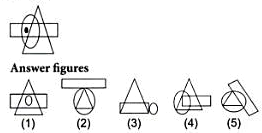
Solution: In the problem figure, one dot appers in a region common to both circle and rectangle only. Such a region is present in the answer figure (5). Choice (5)
Question 2
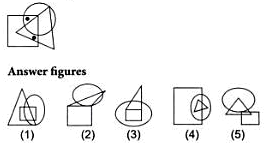
Solution: In the problem figure, there are two dots. One dot appears in a region common to both circle and square only and another dot appears in a region common to both triangle and square only. Such a region is present only in the answer figure (1).
Choice (1)
Question 3
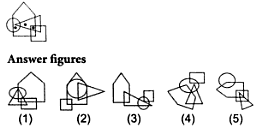
Solution: In the problem figure, there are 3 dots. One dot appears in a region common to all the three figures; another dot appears in a region common to both circle and square only and another dot appears in a region common to both triangle and square only. Such a region is present only in the answer figure (5).
Choice (5)
Question 4

Solution: In the problem figure, there are 3 dots. One dot appears in a region common to both pentagon and circle only, another dot appears in a region common to both pentagon and triangle only and another dot appears in a region common to pentagon, triangle and square. Such a region is present only in the answer figure (1).
Choice (1)
Question 5

Solution: There are 4 dots in the problem figure. One dot appears in a region common to all the four figures; another dot appears in a region common to hexagon, circle and rectangle only; another dot appears in a region common to hexagon and circle only; another dot appears in a region common to hexagon and rectangle only. Such regions are present only in the answer figure (4). Choice (4)
Dot Situation Questions from Previous Year Exams
Quiz-summary
0 of 20 questions completed
Questions:
- 1
- 2
- 3
- 4
- 5
- 6
- 7
- 8
- 9
- 10
- 11
- 12
- 13
- 14
- 15
- 16
- 17
- 18
- 19
- 20
Information
Dot Situation
You have already completed the quiz before. Hence you can not start it again.
Quiz is loading...
You must sign in or sign up to start the quiz.
You have to finish following quiz, to start this quiz:
Results
0 of 20 questions answered correctly
Your time:
Time has elapsed
You have reached 0 of 0 points, (0)
| Average score |
|
| Your score |
|
Categories
- Not categorized 0%
- 1
- 2
- 3
- 4
- 5
- 6
- 7
- 8
- 9
- 10
- 11
- 12
- 13
- 14
- 15
- 16
- 17
- 18
- 19
- 20
- Answered
- Review
-
Question 1 of 20
1. Question
1 pointsFrom amongst the figures marked (1), (2), (3) and (4), select the figure which satisfies the same conditions of placement of the dots as in figure (X).
Select the figure which satisfies the same conditions of placement of the dots as in Figure-X.
 Correct
Correct
In fig. (X), the dot is contained in the region common to the triangle and the square only. Out of the four alternatives, only fig. (1) contains a region common to the triangle and the square only.
Incorrect
In fig. (X), the dot is contained in the region common to the triangle and the square only. Out of the four alternatives, only fig. (1) contains a region common to the triangle and the square only.
-
Question 2 of 20
2. Question
1 pointsSelect the figure which satisfies the same conditions of placement of the dots as in Figure-X.
 Correct
Correct
In fig. (X), the dot is contained in the region common to the square and the circle only. Out of the four alternatives, only fig. (4) contains a region common to the square and the circle only.
Incorrect
In fig. (X), the dot is contained in the region common to the square and the circle only. Out of the four alternatives, only fig. (4) contains a region common to the square and the circle only.
-
Question 3 of 20
3. Question
1 pointsSelect the figure which satisfies the same conditions of placement of the dots as in Figure-X.
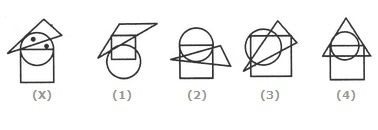 Correct
Correct
In fig. (X), one of the dots lies in the region common to the circle and the triangle only and the other dot lies in the circle alone. In each of the two figures (1) and (2), there is no region common to the circle and the triangle only. In fig. (4) there is no region which lies in the circle alone. Only fig. (3) consists of both the types of regions.
Incorrect
In fig. (X), one of the dots lies in the region common to the circle and the triangle only and the other dot lies in the circle alone. In each of the two figures (1) and (2), there is no region common to the circle and the triangle only. In fig. (4) there is no region which lies in the circle alone. Only fig. (3) consists of both the types of regions.
-
Question 4 of 20
4. Question
1 pointsSelect the figure which satisfies the same conditions of placement of the dots as in Figure-X.
 Correct
Correct
In fig. (X), one of the dots lies in the region common to the circle and the triangle only, another dot lies in the region common to all the three figures - the circle, the square and the triangle and the third dot lies in the region common to the circle and the square only. In each of the figures (1) and (3), there is no region common to the circle and the square only and in fig. (2), there is no region common to the circle and the triangle only. Only fig. (4) consists of all the three types of regions.
Incorrect
In fig. (X), one of the dots lies in the region common to the circle and the triangle only, another dot lies in the region common to all the three figures - the circle, the square and the triangle and the third dot lies in the region common to the circle and the square only. In each of the figures (1) and (3), there is no region common to the circle and the square only and in fig. (2), there is no region common to the circle and the triangle only. Only fig. (4) consists of all the three types of regions.
-
Question 5 of 20
5. Question
1 pointsSelect the figure which satisfies the same conditions of placement of the dots as in Figure-X.
 Correct
Correct
In fig. (X), one of the dots is placed in the region common to the circle and the triangle only and another dot is placed in the region common to the square and the triangle only. In each of the three alternatives (2), (3) and (4), there is no region common to the square and the triangle only. Only fig. (1) consists of both the types of regions.
Incorrect
In fig. (X), one of the dots is placed in the region common to the circle and the triangle only and another dot is placed in the region common to the square and the triangle only. In each of the three alternatives (2), (3) and (4), there is no region common to the square and the triangle only. Only fig. (1) consists of both the types of regions.
-
Question 6 of 20
6. Question
1 pointsSelect the figure which satisfies the same conditions of placement of the dots as in Figure-X.
 Correct
Correct
In fig. (X), one of the dots lies in the region common to the circle the triangle and the rectangle only, another dot lies in the region common to the circle and the triangle only and the third dot lies in the region common to the circle, the square and the triangle only. In each of the figures (1), (2) and (4) there is no region common to the circle, the triangle and the rectangle only. Only fig. (3) consists of all the three types of regions.
Incorrect
In fig. (X), one of the dots lies in the region common to the circle the triangle and the rectangle only, another dot lies in the region common to the circle and the triangle only and the third dot lies in the region common to the circle, the square and the triangle only. In each of the figures (1), (2) and (4) there is no region common to the circle, the triangle and the rectangle only. Only fig. (3) consists of all the three types of regions.
-
Question 7 of 20
7. Question
1 pointsSelect the figure which satisfies the same conditions of placement of the dots as in Figure-X.
 Correct
Correct
In fig. (X), one of the dots lies in the region common to the circle and the triangle only and the other dot lies in the region common to the square and the triangle only. In each of the figures (2), (3) and (4), there is no region common to the circle and the triangle only. Only fig. (1) consists of both the types of regions.
Incorrect
In fig. (X), one of the dots lies in the region common to the circle and the triangle only and the other dot lies in the region common to the square and the triangle only. In each of the figures (2), (3) and (4), there is no region common to the circle and the triangle only. Only fig. (1) consists of both the types of regions.
-
Question 8 of 20
8. Question
1 pointsSelect the figure which satisfies the same conditions of placement of the dots as in Figure-X.
 Correct
Correct
In fig. (X), one of the dots lies in the region common to the circle and the square only, another dot lies in the region common to all the three figures - the circle, the square and the triangle and the third dot lies in the region common to the circle and the triangle only. In each of the alternatives (1), (3) and (4), there is no region common to the circle and the triangle only. Only fig. (2) consists of all the three types of regions.
Incorrect
In fig. (X), one of the dots lies in the region common to the circle and the square only, another dot lies in the region common to all the three figures - the circle, the square and the triangle and the third dot lies in the region common to the circle and the triangle only. In each of the alternatives (1), (3) and (4), there is no region common to the circle and the triangle only. Only fig. (2) consists of all the three types of regions.
-
Question 9 of 20
9. Question
1 pointsSelect the figure which satisfies the same conditions of placement of the dots as in Figure-X.
 Correct
Correct
In fig. (X), one of the dots lies in the region common to the square and the triangle only and the other dot lies in the region common to all the three figures - the circle, the square and the triangle. In each of the alternatives (1) and (2), there is no region common to the square and the triangle only. In alternative (3), there is no region common to all the three figures. Only, alternative (4) consists of both the types of regions.
Incorrect
In fig. (X), one of the dots lies in the region common to the square and the triangle only and the other dot lies in the region common to all the three figures - the circle, the square and the triangle. In each of the alternatives (1) and (2), there is no region common to the square and the triangle only. In alternative (3), there is no region common to all the three figures. Only, alternative (4) consists of both the types of regions.
-
Question 10 of 20
10. Question
1 pointsSelect the figure which satisfies the same conditions of placement of the dots as in Figure-X.
 Correct
Correct
In fig. (X), one of the dots lies in the square alone, another dot lies in the region common to the square and the triangle only and the third dot lies in the region common to the circle and the triangle. In fig. (1), there is no region which lies in the square alone. In each of the figures (2) and (4), there is no region common to the circle and the triangle only. Only, fig. (3) consists of all the three types of regions.
Incorrect
In fig. (X), one of the dots lies in the square alone, another dot lies in the region common to the square and the triangle only and the third dot lies in the region common to the circle and the triangle. In fig. (1), there is no region which lies in the square alone. In each of the figures (2) and (4), there is no region common to the circle and the triangle only. Only, fig. (3) consists of all the three types of regions.
-
Question 11 of 20
11. Question
1 pointsSelect the figure which satisfies the same conditions of placement of the dots as in Figure-X.
 Correct
Correct
In fig. (X), one of the dots lies in the square alone, another dot lies in the triangle alone and the third dot lies in the region common to the circle and the square. In fig. (2) there is no region that lies in the square alone, in fig. (3) there is no region that lies in the triangle alone and in fig. (4) there is no region that lies in the region common to the circle and the square only. Only fig. (1) consists of all the three types of regions.
Incorrect
In fig. (X), one of the dots lies in the square alone, another dot lies in the triangle alone and the third dot lies in the region common to the circle and the square. In fig. (2) there is no region that lies in the square alone, in fig. (3) there is no region that lies in the triangle alone and in fig. (4) there is no region that lies in the region common to the circle and the square only. Only fig. (1) consists of all the three types of regions.
-
Question 12 of 20
12. Question
1 pointsSelect the figure which satisfies the same conditions of placement of the dots as in Figure-X.
 Correct
Correct
In fig. (X), one of the dots lies in the region common to the circle and the triangle only and the other dot lies in the region common to the circle and the square only. In each of the figures (1), (3) and (4), there is no region common to the circle and the triangle only. Only fig. (2) consists of both the types of regions.
Incorrect
In fig. (X), one of the dots lies in the region common to the circle and the triangle only and the other dot lies in the region common to the circle and the square only. In each of the figures (1), (3) and (4), there is no region common to the circle and the triangle only. Only fig. (2) consists of both the types of regions.
-
Question 13 of 20
13. Question
1 pointsSelect the figure which satisfies the same conditions of placement of the dots as in Figure-X.
 Correct
Correct
In fig. (X), one of the dots lies in the region common to the circle and the rectangle only and the other dot lies in the region common to the circle, the square and the triangle only. In each of the figures (1) and (2), there is no region common to the circle and the rectangle only. In fig. (3), there is no region common to the circle, the square and the triangle only. Only fig. (4) consists of both the types of regions.
Incorrect
In fig. (X), one of the dots lies in the region common to the circle and the rectangle only and the other dot lies in the region common to the circle, the square and the triangle only. In each of the figures (1) and (2), there is no region common to the circle and the rectangle only. In fig. (3), there is no region common to the circle, the square and the triangle only. Only fig. (4) consists of both the types of regions.
-
Question 14 of 20
14. Question
1 pointsSelect the figure which satisfies the same conditions of placement of the dots as in Figure-X.
 Correct
Correct
In fig. (X), one of the dots lies in the region common to the circle and the square only, another dot lies in the region common to all the three figures - the circle, the square and the triangle and the third dot lies in the circle alone. In fig. (2) there is no region common to the circle and the square only and in each of the figures (3) and (4) there are regions which lie in the circle alone. Only fig. (1) consists of all the three types of regions.
Incorrect
In fig. (X), one of the dots lies in the region common to the circle and the square only, another dot lies in the region common to all the three figures - the circle, the square and the triangle and the third dot lies in the circle alone. In fig. (2) there is no region common to the circle and the square only and in each of the figures (3) and (4) there are regions which lie in the circle alone. Only fig. (1) consists of all the three types of regions.
-
Question 15 of 20
15. Question
1 pointsSelect the figure which satisfies the same conditions of placement of the dots as in Figure-X.
 Correct
Correct
In fig. (X), one of the dots lies in the triangle alone, another dot lies in the region common to the square and the triangle only and the third dot lies in the region common to the circle and the square only. In each of the figures (1), (2) and (4), there is no region common to the square and the triangle only. Only fig. (3) consists of all the three types of regions.
Incorrect
In fig. (X), one of the dots lies in the triangle alone, another dot lies in the region common to the square and the triangle only and the third dot lies in the region common to the circle and the square only. In each of the figures (1), (2) and (4), there is no region common to the square and the triangle only. Only fig. (3) consists of all the three types of regions.
-
Question 16 of 20
16. Question
1 pointsSelect the figure which satisfies the same conditions of placement of the dots as in Figure-X.
 Correct
Correct
In fig. (X), the dot lies in the region common to all the three figures - square, triangle and circle. Out of the four alternatives, only fig. (2) contains a region common to all the three figures. Hence, fig. (2) is the answer.
Incorrect
In fig. (X), the dot lies in the region common to all the three figures - square, triangle and circle. Out of the four alternatives, only fig. (2) contains a region common to all the three figures. Hence, fig. (2) is the answer.
-
Question 17 of 20
17. Question
1 pointsSelect the figure which satisfies the same conditions of placement of the dots as in Figure-X.
 Correct
Correct
In fig. (X), one of the dots lies in the region common to the circle and the triangle only, another dot lies in the region common to the circle, the square and the triangle only and the third dot lies in the rectangle alone. In figures (1) and (4) there is no region common to the circle and the triangle only. In fig. (3) there is no region which lies in the rectangle alone. Only fig. (2) contains all the three types of regions.
Incorrect
In fig. (X), one of the dots lies in the region common to the circle and the triangle only, another dot lies in the region common to the circle, the square and the triangle only and the third dot lies in the rectangle alone. In figures (1) and (4) there is no region common to the circle and the triangle only. In fig. (3) there is no region which lies in the rectangle alone. Only fig. (2) contains all the three types of regions.
-
Question 18 of 20
18. Question
1 pointsSelect the figure which satisfies the same conditions of placement of the dots as in Figure-X.
 Correct
Correct
In fig. (X), one of the dots lies in the region common to the circle, the square and the rectangle only, another dot lies in the region common to all the four elements - the circle, the square, the triangle and the rectangle and the third dot lies in the region common to the circle, the triangle and the rectangle only. In fig. (1), there is no region common to the circle, the triangle and the rectangle only. In each of the figures (3) and (4) there is no region common to all the four elements - the circle, the square, the triangle and the rectangle. Only fig. (2) consists of all the three types of regions.
Incorrect
In fig. (X), one of the dots lies in the region common to the circle, the square and the rectangle only, another dot lies in the region common to all the four elements - the circle, the square, the triangle and the rectangle and the third dot lies in the region common to the circle, the triangle and the rectangle only. In fig. (1), there is no region common to the circle, the triangle and the rectangle only. In each of the figures (3) and (4) there is no region common to all the four elements - the circle, the square, the triangle and the rectangle. Only fig. (2) consists of all the three types of regions.
-
Question 19 of 20
19. Question
1 pointsSelect the figure which satisfies the same conditions of placement of the dots as in Figure-X.
 Correct
Correct
In fig. (X), one of the dots lies in the region common to the circle and the rectangle only, another dot lies in the region common to the circle, the square and the rectangle only and the third dot lies in the region common to the circle, the square and the triangle only. In each of the figures (1) and (3) there is no region common to the circle, the square and the rectangle only and in fig. (2), there is no region common to the circle, the square and the triangle only. Only, fig. (4) consists of all the three types of regions.
Incorrect
In fig. (X), one of the dots lies in the region common to the circle and the rectangle only, another dot lies in the region common to the circle, the square and the rectangle only and the third dot lies in the region common to the circle, the square and the triangle only. In each of the figures (1) and (3) there is no region common to the circle, the square and the rectangle only and in fig. (2), there is no region common to the circle, the square and the triangle only. Only, fig. (4) consists of all the three types of regions.
-
Question 20 of 20
20. Question
1 pointsSelect the figure which satisfies the same conditions of placement of the dots as in Figure-X.
 Correct
Correct
In fig. (X), one of the dots lies in the region common to the circle and the triangle only, another dot lies in the region common to the circle, the square and the triangle only and the third dot lies in the region common to the circle, the square and the rectangle only. In each of the figures (1) and (3) there is no region common to the circle and the triangle only. In fig. (4) there is no region common to the circle, the square and the rectangle only. Only fig. (2) consists of all the three types of regions.
Incorrect
In fig. (X), one of the dots lies in the region common to the circle and the triangle only, another dot lies in the region common to the circle, the square and the triangle only and the third dot lies in the region common to the circle, the square and the rectangle only. In each of the figures (1) and (3) there is no region common to the circle and the triangle only. In fig. (4) there is no region common to the circle, the square and the rectangle only. Only fig. (2) consists of all the three types of regions.
Dot Situation Video Lecture


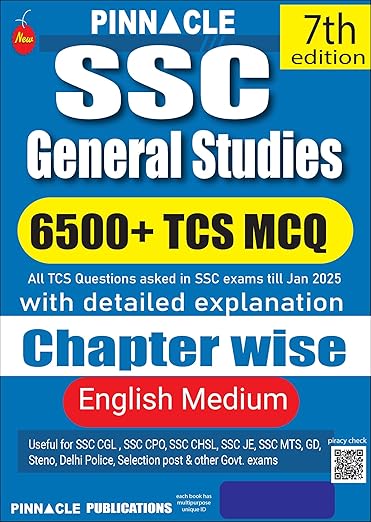

0 Comments